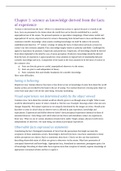Samenvatting
Landelijke Kennis Toets Engels - LKT in 1 keer gehaald met deze complete samenvatting
- Vak
- Instelling
Deze samenvatting bevalt alles wat je moet weten voor de LKT van Grammatica deel A, B en C, naar kennis van land en samenleving, geschiedenis en geografie. Er staan veel afbeeldingen bij om je een beeld bij bepaalde onderwerpen te geven (personen, symbolen, gebeurtenissen, plaats van landen et...
[Meer zien]




